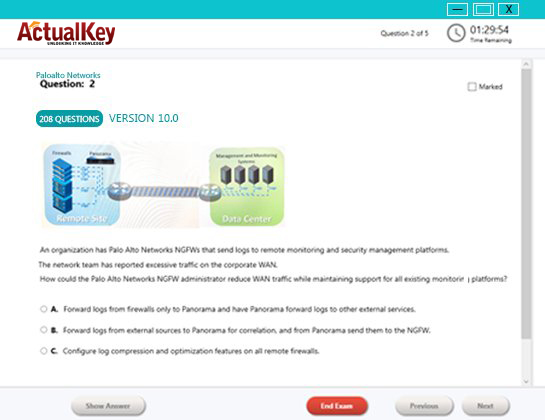Limited Time 30% Discount Offer Use Code - off30
Actualkey Prepration Latest 70-450 : PRO: Designing, Optimizing and Maintaining a Database Administrative Solution Using Microsoft SQL Server 2008 Questions and Answers PDF's, Verified Answers via Experts - Pass Your Exam For Sure and instant Downloads - "Money Back Guarantee".
| Vendor | Microsoft |
| Certification | MCITP |
| Exam Code | 70-450 |
| Title | PRO: Designing, Optimizing and Maintaining a Database Administrative Solution Using Microsoft SQL Server 2008 |
| No Of Questions | 189 |
| Last Updated | September 16,2024 |
| Product Type | Q & A with Explanation |
| Bundel Pack Included | PDF + Offline / Andriod Testing Engine and Simulator |
70-450
PRO: Designing, Optimizing and Maintaining a Database Administrative Solution Using Microsoft SQL Server 2008
About this Exam
This exam is targeted at the professional level SQL Server 2008 Database Administrator. It tests your ability to make appropriate design and technology choice considerations for your SQL Server 2008 installations.
Audience Profile
Candidates for this exam work in an environment in which Microsoft SQL Server 2008 is used for database solutions. Candidates should have at least three years of experience administering databases in an enterprise-level organization and designing, deploying, optimizing, maintaining, and supporting database service life cycle. Candidates should also have experience with the following:
* Defining high-availability solutions
* Data distribution
* Automating administrative tasks (for example, checking db stats, backups)
* Maintaining administrative tasks (for example, determining index rebuild time, file groups for backup)
* Defining security solutions
* Monitoring and troubleshooting the database server
* Performance optimization (for example, physical tuning, including hardware, operating system, instance-level tuning), PerfMon
* Designing and executing deployments
* Deployments and migration
* Defining the infrastructure (for example, storage, hardware, and number of servers or instances)
Credit Toward Certification
Exam 70-450: PRO: Designing, Optimizing and Maintaining a Database Administrative Solution Using Microsoft SQL Server 2008: counts as credit toward the following certification(s):Microsoft Certified IT Professional: Database Administrator 2008
This Training Will Cover
This exam measures your ability to accomplish the technical tasks listed below.The percentages indicate the relative weight of each major topic area on the exam.
Designing a SQL Server Instance and a Database Solution (14 percent)
* Design for CPU, memory, and storage capacity requirements.
* This objective may include but is not limited to: RAID, calculating table size, IO throughput, transaction per second, data compression, non-uniform memory access (NUMA), tempdb capacity
Design SQL Server instances.
* This objective may include but is not limited to: instance configuration, surface area configuration, CPU affinity, memory allocation, max degree of parallelism (MAXDOP), collation
* Design physical database and object placement.
* This objective may include but is not limited to: heap and index placement, filestream, data and log files, filegroups, partition placement, large object placement, full text catalog
Design a migration, consolidation, and upgrade strategy.
* This objective may include but is not limited to: multi-instance considerations, SQL Server version upgrade, instance and database collation, server-level and instance-level objects, service pack application
Designing a Database Server Security Solution (15 percent)
Design instance authentication
* This objective may include but is not limited to: choosing authentication type, logon triggers, regulatory requirements
Design instance-level security configurations
* This objective may include but is not limited to: Windowsservice accounts, filestream, proxy, credentials, instance-level permissions, certificate and key management, endpoint security, using SSL certificates, TCP ports
Design database, schema, and object security paramaters
* This objective may include but is not limited to: users, roles, certificate and key management, Service broker, Common Language Runtime (CLR), ownership chains
Design a security policy and an audit plan
* This objective may include but is not limited to: Policy-Based Management Framework, security functions, sp_helprotect, catalog views, extended events, notifications
Design an encryption strategy
* This objective may include but is not limited to: Transparent Data Encryption, encrypting protected data, certificate and key management, filestream
Designing a Database Solution for High Availability (15 percent)
Design a failover clustering solution
* This objective may include but is not limited to: cluster resource group, cluster setup considerations, number of nodes, service accounts
Design database mirroring
* This objective may include but is not limited to: whether to use a witness server, Windows Server considerations, suspend vs. stop, automatic or manual failover, automatic page repair, database snapshots for reporting, managing instance-level objects
Design a high-availability solution that is based on replication
* This objective may include but is not limited to: different replication types, topologies, recover from replication failure, synchronization, health monitoring
Design a high-availability solution that is based on log shipping
* This objective may include but is not limited to: manage instance-level objects, changing roles, reporting secondary instance for reporting, monitor server, reinitializing, consistency check on secondary instance
Select high-availability technologies based on business requirements
* This objective may include but is not limited to: failover clustering, database mirroring, log shipping, replication
Designing a Backup and Recovery Solution (20 percent)
Design a backup strategy
* This objective may include but is not limited to: recovery model, compression, choosing backup types, scheduling, backup media, file and filegroups backup, verifying backups, key management, mirrored backups, cluster considerations
Design a recovery strategy
* This objective may include but is not limited to: page, file, filegroup, partial and online restores, orphan users, instance rebuild, encryption considerations, handling media failures, transaction logs, point in time and mark recovery, filestreams
Design a recovery test plan
* This objective may include but is not limited to: log shipping, replication, hardware considerations, scheduling a database restore test, handling high availability failures
Designing a Monitoring Strategy (13 percent)
Design a monitoring solution at the operating system level
* This objective may include but is not limited to: system monitor counters, event logs, dynamic management views and functions, Windows Management Instrumentation (WMI), remote monitoring, analyze results
Design a monitoring solution at the instance level
* This objective may include but is not limited to: instance, database and object monitoring, data collection, event notifications, dynamic management objects, analyze results
Design a solution to monitor performance and concurrency
* This objective may include but is not limited to: Dedicated Administrator Connection (DAC), locking, blocking, deadlocks, dynamic management objects, index utilization, tracing, analyze
Designing a Strategy to Maintain and Manage Databases (14 percent)
Design a maintenance strategy for database servers
* This objective may include but is not limited to: rebuild for page-level compression, index and heap maintenance, partition management, statistics
Design a solution to govern resources
* This objective may include but is not limited to: Resource Governor (CPU, memory, number of requests per second; resource pools, resource groups), query governor
Design policies by using Policy-Based Management
* This objective may include but is not limited to: designing policies and conditions
Design a data compression strategy
* This objective may include but is not limited to: row vs. page level, update frequency, compression ratio, compressing partitions, specific indexes
Design a management automation strategy
* This objective may include but is not limited to: SQL Server PowerShell, Windows Management Instrumentation (WMI), SQL Server Agent, event notifications, DDL triggers
Designing a Strategy for Data Distribution (9 percent)
Administer SQL Server Integration Services (SSIS) packages
* This objective may include but is not limited to: design security for accessing packages, troubleshoot and restart package, schedule package execution, deploy packages to same or different instances
Design a strategy to use linked servers
* This objective may include but is not limited to: security, providers, distributed transactions
Design a replication strategy for data distribution
* This objective may include but is not limited to: selecting replication types, conflict resolution, health monitoring, horizontal and vertical partitioning
I Got My Success Due To Actualkey 70-450 Bundle Pack Actualkey experts I got passed in the 70-450 exam without any worries at all, these exam material products gave me the reason to relax.
Budi Saptarmat
Yahoo! Got Successfully Through The 70-450 Exam Passing Exam is not a easy thanks to Acutalkey.com for providing me actual 70-450 PRO: Designing, Optimizing and Maintaining a Database Administrative Solution Using Microsoft SQL Server 2008 training with there included the Offline and Android simulators helps me success
Melinda
70-450 Exam Best Preparation I have been preparing for 70-450 PRO: Designing, Optimizing and Maintaining a Database Administrative Solution Using Microsoft SQL Server 2008, I was not sure that I'll be able to pass because of the fact that I am not a good student however;Actualkey.com provided me best and simple exam training pdf's and I passed. I now recommend everyone
Antonio Moreno
Actualkey.com 70-450 Offline Simulator is Best My choice to select Actualkey.com and go for the preparation 70-450 PRO: Designing, Optimizing and Maintaining a Database Administrative Solution Using Microsoft SQL Server 2008, because I got the short way with the easy way
Liliane Meichner
Actualkey.com 70-450 Exam PDF"s passed with in a week 70-450 exam pdf's that's amazing
James Wilson
Microsoft - RELATED EXAMS
Designing a Database Server Infrastructure by Using Microsoft SQL Server 2005
Questions: 92 Questions | September 16, 2024
Optimizing and Maintaining a Database Administration Solution by Using SQL Server 2005
Questions: 215 | September 16, 2024
UPGRADE: MCDBA Skills to MCITP Database Administrator by Using Microsoft SQL Server 2005
Questions: 186 Questions | September 16, 2024
Microsoft .NET Framework 2.0 - Windows-Based Client Development
Questions: 245 Questions | September 16, 2024
Microsoft .NET Framework 2.0 - Distributed Application Development
Questions: 144 | September 16, 2024
Microsoft .NET Framework 2.0-Application Development Foundation
Questions: 456 | September 16, 2024
Designing and Developing Web-Based Applications by Using the Microsoft .NET Framework
Questions: 74 | September 16, 2024
Designing and Developing Windows-Based Applications by Using the Microsoft .NET Framework
Questions: 72 Questions | September 16, 2024
Designing and Developing Enterprise Applications by Using the Microsoft .NET Framework
Questions: 86 | September 16, 2024
UPGRADE: MCAD Skills to MCPD Web Developer by Using the Microsoft .NET Framework
Questions: 584 | September 16, 2024
UPGRADE: MCAD Skills to MCPD Windows Developer by Using the Microsoft .NET Framework
Questions: 559 | September 16, 2024
UPGRADE: MCSD Microsoft .NET Skills to MCPD Enterprise Application Developer: Part 1
Questions: 609 | September 16, 2024
UPGRADE: MCSD Microsoft .NET Skills to MCPD Enterprise Application Developer: Part 2
Questions: 168 | September 16, 2024
TS: Deploying and Maintaining Windows Vista Client and 2007 Microsoft Office System Desktops
Questions: 92 | September 16, 2024
Windows Server 2008 Applications Infrastructure, Configuring
Questions: 494 | September 16, 2024
TS: Upgrading from Windows Server 2003 MCSA to, Windows Server 2008, Technology Specializations
Questions: 576 | September 16, 2024
Designing a Microsoft Office Enterprise Project Management (EPM) Solution
Questions: 50 Questions | September 16, 2024
Customizing Portal Solutions with Microsoft SharePoint Products and Technologies
Questions: 75 | September 16, 2024
Deploying Business Desktops with Microsoft Windows Server 2003 and Microsoft Office 2003
Questions: 53 | September 16, 2024
Implementing and Administering Security in a Microsoft Windows Server 2003 Network
Questions: 288 | September 16, 2024
Designing, Deploying, and Managing a Network Solution for a Small- and Medium-Sized Business
Questions: 204 | September 16, 2024
Supporting Users and Troubleshooting a Microsoft Windows XP Operating System
Questions: 114 | September 16, 2024
TS: Microsoft SQL Server 2008, Business Intelligence Development and Maintenance
Questions: 399 | September 16, 2024
PRO: Designing, Optimizing and Maintaining a Database Administrative Solution Using Microsoft SQL Server 2008
Questions: 189 | September 16, 2024
Developing E-Business Solutions Using Microsoft BizTalk Server 2004
Questions: 40 | September 16, 2024
Developing Microsoft Office Solutions Using XML with Office Professional Edition 2003
Questions: 50 | September 16, 2024
Planning and Building a Messaging and Collaboration Environment Using Microsoft Office System and Microsoft Windows Server 2003
Questions: 61 | September 16, 2024
TS: Microsoft .NET Framework 3.5, ADO.NET Application Development
Questions: 287 | September 16, 2024
TS: Microsoft .NET Framework 3.5, ASP.NET Application Development
Questions: 364 | September 16, 2024
TS: Microsoft Office Project Server 2007, Managing Projects
Questions: 145 | September 16, 2024
TS: Microsoft .NET Framework 3.5, Windows Forms Application Development
Questions: 48 | September 16, 2024
Upgrade: Transition Your MCITP SQL Server 2005 DBA to MCITP SQL Server 2008
Questions: 98 | September 16, 2024
Pro: Designing and Deploying Messaging Solutions with Microsoft Exchange Server 2010
Questions: 379 | July 1, 2024
Pro: Designing and Developing ASP.NET Applications Using the Microsoft .NET Framework 3.5
Questions: 281 | September 16, 2024
TS: Microsoft SQL Server 2008, Implementation and Maintenance
Questions: 328 | September 16, 2024
Microsoft System Center Configuration Manager 2007,Configuring
Questions: 184 | September 16, 2024
PRO: Designing and Developing Microsoft SharePoint 2010 Applications
Questions: 200 | September 16, 2024
Upgrading to Windows 7 MCITP Enterprise Desktop Support Technician
Questions: 50 | September 16, 2024
TS: Windows Applications Development with Microsoft .NET Framework 4
Questions: 278 | September 16, 2024
TS: Windows Communication Foundation Development with Microsoft .NET Framework 4
Questions: 473 | September 16, 2024
TS: Web Applications Development with Microsoft .NET Framework 4
Questions: 405 | September 16, 2024
Pro: Designing and Developing Web Applications Using Microsoft .NET Framework 4
Questions: 288 | September 16, 2024
TS: Developing Business Process and Integration Solutions by Using Microsoft BizTalk Server 2010
Questions: 100 | September 16, 2024
Designing and Providing Microsoft Volume Licensing Solutions to Small and Medium Organizations
Questions: 232 | September 16, 2024
TS: Forefront Protection for Endpoints and Applications, Configuring
Questions: 105 | September 16, 2024
Upgrade: Transition Your MCITP SQL Server 2005 DBD to MCITP SQL Server 2008 DBD
Questions: 154 | July 1, 2024
Pro: Windows Server 2008 R2, Virtualization Administrator
Questions: 176 | September 16, 2024
PRO: Designing Database Solutions and Data Access Using Microsoft SQL Server 2008
Questions: 183 | July 1, 2024
Managing and Maintaining a Microsoft Windows Server 2003 Environment
Questions: 450 | July 1, 2024
Implementing Data Models and Reports with Microsoft SQL Server 2012
Questions: 330 | July 1, 2024
Implementing a Data Warehouse with Microsoft SQL Server 2012
Questions: 322 | September 16, 2024
Transition Your MCTS on SQL Server 2008 to MCSA: SQL Server 2012, Part 2
Questions: 300 | September 16, 2024
Configuring and Deploying a Private Cloud with System Center 2012
Questions: 462 | September 16, 2024
Monitoring and Operating a Private Cloud with System Center 2012
Questions: 457 | September 16, 2024
Administering and Deploying System Center 2012 Configuration Manager
Questions: 208 | September 16, 2024
Microsoft Dynamics AX 2012 Process Manufacturing Production and Logistics
Questions: 149 | July 1, 2024
Advanced Metro style App Development using HTML5 and JavaScript
Questions: 225 | September 16, 2024
Transition Your MCTS on SQL Server 2008 to MCSA: SQL Server 2012, Part 1
Questions: 230 | September 16, 2024
Transition Your MCITP: Database Administrator 2008 or MCITP: Database Developer 2008 to MCSE: Data Platform
Questions: 261 | September 16, 2024
Transition Your MCITP: Business Intelligence Developer 2008 to MCSE: Business Intelligence
Questions: 132 | September 16, 2024
Designing Database Solutions for Microsoft SQL Server 2012
Questions: 231 | September 16, 2024
Designing Business Intelligence Solutions with Microsoft SQL Server 2012 Exam
Questions: 314 | September 16, 2024
Microsoft Programming in HTML5 with JavaScript and CSS3 Exam
Questions: 342 | September 16, 2024
Delivering Continuous Value with Visual Studio 2012 Application Lifecycle Management
Questions: 219 | July 1, 2024
Enterprise Voice & Online Services with Microsoft Lync Server 2013
Questions: 158 | September 16, 2024
Developing Microsoft SharePoint Server 2013 Core Solutions
Questions: 181 | September 16, 2024
Upgrade your MCPD: Web Developer 4 to MCSD: Web Applications
Questions: 229 | September 16, 2024
Essentials of Developing Windows Metro style Apps using C#
Questions: 168 | September 16, 2024
Server Virtualization with Windows Server Hyper-V and System Center
Questions: 149 | September 16, 2024
Essentials of Developing Windows Metro style Apps using HTML5 and JavaScript
Questions: 166 | September 16, 2024
TS: Windows Small Business Server 2011 Standard, Configuring
Questions: 55 | September 16, 2024
TS: MS Internet Security & Acceleration Server 2006, Configuring
Questions: 80 | September 16, 2024
TS: Microsoft System Center Operations Manager 2007, Configuring
Questions: 94 | September 16, 2024
TS: System Center Virtual Machine Manager 2008, Configuring
Questions: 45 | September 16, 2024
PRO: Designing a Business Intelligence Infrastructure Using Microsoft SQL Server 2008
Questions: 115 | September 16, 2024
Upgrade: Transition Your MCITP SQL Server 2005 BI Developer to MCITP SQL Server 2008 BI Developer
Questions: 203 | September 16, 2024
Recertification for MCSD: Application Lifecycle Management
Questions: 292 | September 16, 2024
TS: Microsoft .NET Framework 3.5 Windows Presentation Foundation Application Development
Questions: 101 | September 16, 2024
TS: Microsoft .NET Framework 3.5 - Windows Communication Foundation
Questions: 270 | September 16, 2024
TS: Visual Studio Team Foundation Server 2010, Administration
Questions: 72 | September 16, 2024
Pro: Designing and Developing Windows Applications Using Microsoft .NET Framework 4
Questions: 239 | September 16, 2024
TS: Microsoft Windows SharePoint Services 3.0 Application Development
Questions: 109 | September 16, 2024
Upgrade: Transition your MCPD Enterprise Application Developer Skills to MCPD Enterprise Application Developer 3.5, Part 1
Questions: 153 | September 16, 2024
UPGRADE: Transition your MCPD Enterprise Application Developer Skills to MCPD Enterprise Application Developer 3.5, Part 2
Questions: 123 | September 16, 2024
TS: System Center Data Protection Manager 2007, Configuring
Questions: 74 | September 16, 2024
Designing and Providing Microsoft Volume Licensing Solutions to Large Organizations
Questions: 126 | September 16, 2024
TS: Designing, Assessing, and Optimizing Software Asset Management (SAM)
Questions: 85 | September 16, 2024
MS Office Communication Server 2007-U.C Voice Specialization
Questions: 174 | September 16, 2024
Microsoft Office Communications Server 2007 R2 U.C. Voice Specialization
Questions: 101 | September 16, 2024
Windows Server 2008 Hosted Environments, Configuring and Managing
Questions: 75 | September 16, 2024
Designing and Providing Microsoft Volume Licensing Solutions to Large Organisations
Questions: 104 | September 16, 2024
Pro: Designing and Developing Windows Applications Using the Microsoft .NET Framework 3.5
Questions: 105 | July 1, 2024
Pro: Designing and Developing Enterprise Applications Using the Microsoft .NET Framework 3.5
Questions: 152 | September 16, 2024
Universal Windows Platform – App Data, Services, and Coding Patterns (beta)
Questions: 47 | September 16, 2024
Universal Windows Platform – App Architecture and UX/UI (beta)
Questions: 76 | September 16, 2024
Microsoft Dynamics AX 2012 R3 CU8 Installation and Configuration
Questions: 48 | July 1, 2024
Designing and Deploying Microsoft Exchange Server 2016 Exam
Questions: 166 | September 16, 2024
Introduction to Programming Using Block-Based Languages (Touch Develop)
Questions: 72 | July 1, 2024
Development, Extensions and Deployment for Microsoft Dynamics 365 for Finance and Operations
Questions: 90 | July 1, 2024
Financial Management in Microsoft Dynamics 365 for Finance and Operations
Questions: 73 | July 1, 2024
Designing and Providing Microsoft Licensing Solutions to Large Organizations
Questions: 195 | July 1, 2024
Distribution and Trade in Microsoft Dynamics 365 for Finance and Operations
Questions: 93 | July 1, 2024
Administering Microsoft System Center Configuration Manager and Cloud Services Integration
Questions: 150 | July 1, 2024
Microsoft Configuring and Operating a Hybrid Cloud with Microsoft Azure Stack Exam
Questions: 99 | July 1, 2024
Microsoft Azure Solutions Architect Certification Transition Exam
Questions: 393 | July 1, 2024
Outlook 2016: Core Communication, Collaboration and Email Skills
Questions: 35 | July 1, 2024
Microsoft Developing Solutions for Microsoft Azure Exam
Questions: 170 / 6 Case Study | July 1, 2024
Designing and Implementing a Data Science Solution on Azure Exam
Questions: 506 | July 28, 2025
Microsoft 365 Teamwork Administrator Certification Transition Exam
Questions: 120 | July 1, 2024
Microsoft Messaging Administrator Certification Transition Exam
Questions: 155 | July 1, 2024
Microsoft Excel 2016: Core Data Analysis, Manipulation, and Presentation Exam
Questions: 35 | November 8, 2024
Microsoft Word 2016: Core Document Creation, Collaboration and Communication Exam
Questions: 35 | November 8, 2024
Microsoft Dynamics 365 for Finance and Operations, Supply Chain Management Exam
Questions: 405 | January 17, 2026
Microsoft Dynamics 365 for Finance and Operations, Manufacturing Exam
Questions: 207 | November 8, 2024
Building Applications and Solutions with Microsoft 365 Core Services Exam
Questions: 242 | July 1, 2024
Microsoft Dynamics 365: Finance and Operations Apps Solution Architect Exam
Questions: 322 | December 19, 2025
Planning and Administering Microsoft Azure for SAP Workloads Exam
Questions: 289 | August 22, 2025
Microsoft Dynamics 365: Finance and Operations Apps Developer Exam
Questions: 316 | January 13, 2026
Administering Relational Databases on Microsoft Azure (beta) Exam
Questions: 341 | December 13, 2024
Microsoft Dynamics 365 Business Central Functional Consultant (beta) Exam
Questions: 213 | September 18, 2025
Configuring and Operating a Hybrid Cloud with Microsoft Azure Stack Hub Exam
Questions: 176 | July 1, 2024
Microsoft Dynamics 365 Fundamentals Customer Engagement Apps (CRM) (beta) Exam
Questions: 159 | October 12, 2024
Microsoft Dynamics 365 Fundamentals Finance and Operations Apps (ERP) Exam
Questions: 151 | May 27, 2025
Configuring and Operating Windows Virtual Desktop on Microsoft Azure Exam
Questions: 261 | July 30, 2025
Designing and Implementing a Microsoft Azure AI Solution (beta) Exam
Questions: 379 | August 7, 2025
Designing and Implementing Microsoft Azure Networking Solutions Exam
Questions: 294 | March 1, 2025
Designing Microsoft Azure Infrastructure Solutions (beta) Exam
Questions: 340 | October 10, 2025
Designing and Implementing Cloud-Native Applications Using Microsoft Azure Cosmos DB (beta) Exam
Questions: 144 | May 24, 2025
Configuring Windows Server Hybrid Advanced Services (beta) Exam
Questions: 255 | November 5, 2025
Administering Windows Server Hybrid Core Infrastructure (beta) Exam
Questions: 256 | September 30, 2025
Microsoft Designing and Implementing Enterprise-Scale Analytics Solutions Using Microsoft Azure and Microsoft Power BI Exam
Questions: 160 | July 1, 2024
Microsoft Dynamics 365 Supply Chain Management Functional Consultant Expert Exam
Questions: 195 | July 12, 2025
Implementing Analytics Solutions Using Microsoft Fabric Exam
Questions: 140 | August 16, 2025
Implementing Data Engineering Solutions Using Microsoft Fabric Exam
Questions: 104 | June 6, 2025
Exams code, certifications, vendor or keywords
![]()
Copyright © 2009 - 2026 Actualkey. All rights reserved.





